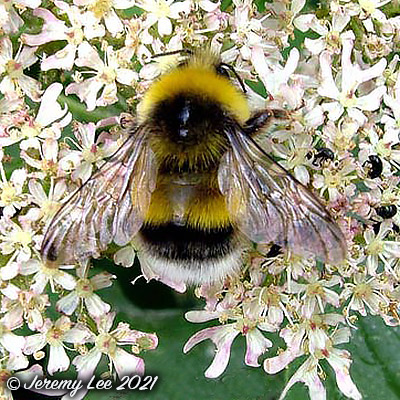
 |
|
Scientific Classifications explained » Amphibians » Ants » Aphids » Bees » Beetles » Birds » Bugs » Butterflies » Caterpillars » Damselflies » Dragonflies » Earwigs » Flies » Frog/Leafhoppers » Fungi » Galls » Grasshoppers » Harvestmen » Hoverflies » Lacewings » Ladybirds » Leaf Mines » Lichens » Mammals » Millipedes » Mosses » Moths » Sawflies » Slugs » Snails » Spiders » Trees & Shrubs » Wasps » Wild Flowers » Woodlice » Postboxes |
UK Nature > Bees > Bombus lucorum

Scientific Name: Bombus lucorum Common Name: White-tailed Bumble Bee Bombus lucorum, or the White-tailed Bumble Bee as it's commonly known, is a large bumblebee with the queen having a length of 18 millimetres (0.71 in) to 22 millimetres (0.87 in) and a wingspan of around 36 millimetres (1.4 in). The workers are normally somewhat smaller. The species has a short proboscis (tongue). The predominating colour is black, with a pale yellow collar, another yellow band on the second tergite (abdominal segment), and a white tail. Both darker and paler forms exist. The hibernating queen emerges very early, in southern Britain usually in March. The nest, which can be very large, up to 400 workers, is usually built underground, often in disused rodent nests. As many other bumblebee males, the males fly in a low patrolling circuit, depositing pheromones on grass to attract young queens. Bombus lucorum visits many flowers such as lavender, hebe, rhododendron, white dead-nettles, thistles and vetches. |
|

https://www.uknature.co.uk is a website dedicated to showing the immense diversity of UK nature and wildlife. Our vast range of habitats, from lowland arable to snow covered mountains, from storm-ravaged coastlines to peaceful inland freshwater lakes and rivers, from dry, sandy heaths to deciduous and coniferous forests, all these habitats contribute to the abundance of UK nature. We have wild birds in huge numbers either residing or visiting our shores (597 recorded species as at July 2013) and we must also not forget the humble back garden with its grass lawns, flower beds filled with nectar rich flowers, shrubs and trees, all designed to attract huge numbers of insects such as bees, moths, butterflies and hoverflies; and finally the small ponds which provide safe havens for frogs, toads, newts and even slow worms and grass snakes. www.uknature.co.uk is the showcase for my personal passion, photographing uknature in all its glory. I sincerely hope you all enjoy the fruits of my labours. This site and all images contained therein is © Jeremy Lee 2004 - 2025. All Rights Reserved. Site design by Jeremy Lee. Site development & IT Support by Stuart Lee. |